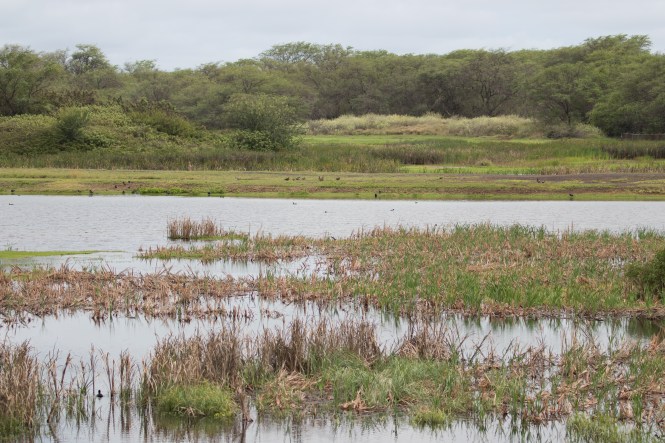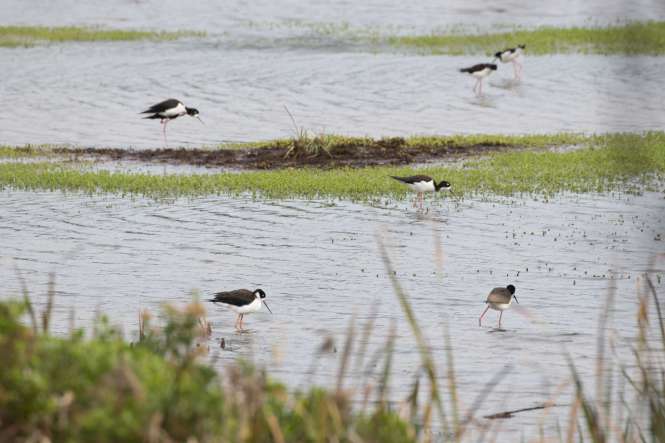Oahu Part 4 – James Campbell NWR
The James Campbell National Wildlife Refuge is located in Oahu’s northernmost point of North Shore. Named after a Scots-Irish industrialist and wealthy landowner and once the site of a major sugar mill factory, the former sugar cane settling ponds are now comprised of 1100 acres of critical coastal wetlands, managed by the U.S. Fish & Wildlife Service to preserve habitat for endangered Hawaiian waterbirds.
It’s what Waikiki would look like had it not been drained for development in the turn of the 20th century (the name Waikiki even means “sprouting fresh waters” in Hawaiian).
The refuge has limited public access. It is closed during breeding and fledging season (Mar-Sept) and only open on off seasons for (free) guided tours on Saturday mornings. Thankfully, this narrow window of opportunity fit our schedule and we made it to the tour. The place was covered with birds.
Guided by longtime volunteer Dick May and local birder Kurt Pohlman, we learned more about endangered Hawaiian waterbirds: Hawaiian Duck (koloa maoli), Hawaiian Coot (‘alae ke’oke’o), Hawaiian Gallinule (Moorhen) (‘alae ‘ula), Hawaiian Stilt (ae’o), and Hawaiian Goose (nēnē). All are endangered endemic Hawaiian waterbirds that are “conservation reliant” so this area is extremely important for their future preservation.
The Hawaiian Duck (both males and females) are mottled brown and resemble the mallard. Hybridization with feral mallards is a major problem for the species.
In fact, there is an unknown number of pure birds within the 300 “Hawaiian duck-like birds” on Oahu. Most are believed to be hybridized, and pure birds are suspected declining, while hybridization increases. Population estimates are unreliable due to the birds being located in remote montane streams and hybridized birds so closely resembling pure birds.
Our guides implied the birds we saw on the refuge were more pure than not, so for what it’s worth, here are photos of “Hawaiian Duck-like birds.”
There was no mistaking the Hawaiian Coot as anything other than a coot. It is slightly smaller than the American Coot, and it has a larger bulbous frontal shield above the bill that is usually all white. Oahu populations range between 500-1000 birds.
The refuge is also favorable to Hawaiian Gallinules. The birds we saw here were more secretive than those in the Waimea Valley Ponds, probably due to fewer interactions with people. Once common on all Hawaiian islands, Hawaiian Gallinules are now only found on Oahu and Kauai. We felt lucky to see them again.
Another unmistakable bird seen throughout the refuge was the Hawaiian Stilt or Ae‘o in Hawaiian, meaning “one standing tall.” A subspecies of the Black-necked Stilt, the endangered Ae’o differs by having more black on its face and neck, and longer bill, tarsus, and tail.
These are some of my favorites.
A week prior to our visit a pair of Nēnē’s had been sighted at the refuge, but we weren’t as privileged this day. The endangered Hawaiian Goose or Nēnē (Hawaii’s state bird) is more commonly found on all other islands besides Oahu. However, in 2014 a pair of Nēnē nested at James Campbell NWR, and hatched two goslings. This was the first pair to nest on the island since the 1700s!
No Nēnēs for us, our consolation was a pair of Cackling Geese on the refuge that was pretty exciting for local folks. I was more excited about a different winter visitor, the Bristle-Thighed Curlew!
Yessss. Bristle-thighed goodness. We watched one hunt along the water’s edge looking for tasty crawfish.
It was obvious by the piles of shellfish remains on the trail where one had been feeding. The birds were a bit skittish and if the group got too close, they would quickly fly away scolding, “Chi-u-eet!” Here’s one flying between two Cattle Egrets (also common).
Another easily spooked winter migrant was the Wandering Tattler; so it was a treat to find one perched cooperatively (if only for the moment) on a fence post.
Then someone pointed out two Ruddy Turnstones in the grass at the bottom of the fence.
Birds everywhere. We also saw Sanderlings, Common Waxbill, Common Myna, Black-crowned Night Heron, sometimes all at once. Pretty sweet combos:
I was sad when the tour ended, but Dick told us about the hopeful future of the refuge; there are plans in the works to bring a road closer to keep the public more involved. In his words: “If you have a refuge that has public support, then the refuge stays,” he says.
We saw four endemic bird species this day. Or three and a half if the ducks are hybrid. Likely so. Either way that’s a pretty special day. And on the way out, Kurt told us a way to access Pearl Harbor National Wildlife Ponds back in Honolulu where we could keep the party going. Birding after-party!
These are the birds that showed up:
The life of the party was the Hawaiian Coot, there were dozens, and the Hawaiian Stilt, I counted at least 30.
So many rockin stilts. Other birds included a Blue-winged Teal, Northern Pintail, both Mallard and “Hawaiian Duck-like birds,” Red-vented Bulbul, Japanese White-eye, Northern Cardinal, and I wish I could have gotten a better photo of the White-faced Ibis but I wasn’t on the V.I.P. list.
We hung out with the stilts until the wee hours of the afternoon. There are so many obstacles for these birds to overcome; introduced predators, rats, dogs, cats, mongoose, bullfrogs, degradation of wetland habitat, alien plants, fish, disease, environmental contaminants. I’m grateful for people like Dick and Kurt who care and to those working to preserve the beautiful wetland spaces.
It was a good day with these birds on the brink!
Mahalo,
Audrey



























I have never actually heard of the bristle-thighed Curlew how awesome!! Wonderful job they are doing to protect these endemics and try to preserve the habitat….I hope they build the road in the highest point so no draining will have to be done, its good and bad no road we don’t get to see them…if we don’t see them they could disappear forever. Sigh….
Enjoying these looks at the birds of Hawaii so much!!
I have mixed feelings about more public access too, it’s a slippery slope! And thank you for your kind comments.
[…] got a tip from a guide on the James Campbell NWR trip to get to Ka‘ena Point early and arrive from the south side. There is a 2.7 mile trail that […]
[…] Especially when I saw a report of Wandering Tattlers in Lincoln City. I forgot that I’ve seen one once before on a fence post in Hawaii. Someone should really keep track of these things […]